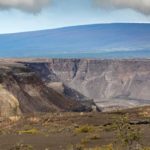As of 9:29am on Sunday, October 16, the following information was released on Mauna Loa’s status.
USGS reported that Mauna Loa is not erupting and there are no signs of an imminent eruption at this time. However, Mauna Loa continues to be in a state of heightened unrest as indicated by increased earthquake activity and inflation of the summit. The current unrest is most likely being driven by renewed input of magma 2-5 miles beneath Mauna Loa’s summit. Monitoring data shows no significant changes in the past day.
During the past 24 hours, HVO detected 35 small-magnitude (below M3.0) earthquakes 2-3 miles below Mokuāʻweoweo caldera and 4-5 miles beneath the upper-elevation northwest flank of Mauna Loa. Both of these regions have historically been seismically active during periods of unrest on Mauna Loa.
The earthquakes and aftershocks from the morning of October 14, 2022 (HVO Information Statement) did not cause any changes in Mauna Loa monitoring data streams. Over the past 48 hours, there have over 150 aftershocks in the Pahala region. Of these, 20 were greater than M2.5 and 4 have been greater than M3.
Global Positioning System (GPS) instruments at the summit and on the flanks of Mauna Loa continue to measure inflation at rates elevated since mid-September. However, tiltmeters at the summit are not showing significant surface deformation over the past week.
Concentrations of sulfur dioxide (SO2), hydrogen sulfide (H2S), and carbon dioxide (CO2), as well as fumarole temperatures, remain stable at the summit and at Sulphur Cone on the upper Southwest Rift Zone. Webcam and thermal camera views have shown no changes to the volcanic landscape on Mauna Loa over the past week.
Mauna Loa’s unrest is likely caused by renewed input of magma into its summit reservoir system. As the reservoir expands it is triggering small earthquakes directly beneath Mokuāʻweoweo caldera and in a region just to the northwest of the caldera. Deeper magma input (greater than 2 miles) is detected by the continued increase in upward movement and extension measured between GPS stations located on the ground surface. Shallower magma input (less than 2 miles) was likely responsible for inflation recorded on the summit tiltmeter during the last two weeks of September.
The current locations of earthquakes and deformation do not necessarily mean that the next eruption will occur there. Mauna Loa remains at an elevated alert level of ADVISORY/YELLOW. The current increase in activity does not suggest that a progression to an eruption is certain, and there are no indications that an eruption is imminent.
HVO will continue to closely monitor Mauna Loa for changes.
Visit https://www.usgs.gov/volcanoes/mauna-loa/monitoring for more information on Mauna Loa.
USGS Photo
